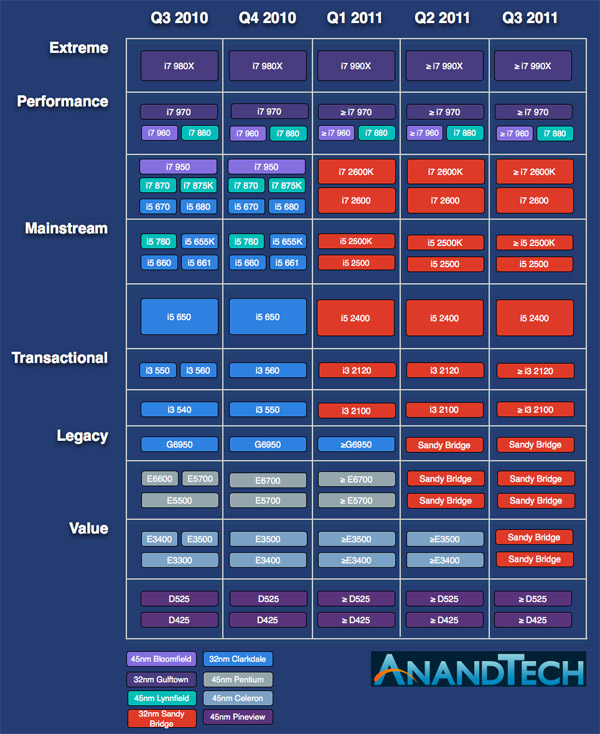The Sandy Bridge Preview
by Anand Lal Shimpi on August 27, 2010 2:38 PM ESTThe Roadmap & Pricing
I’ve defined the launch parts earlier in this article, but now I’m going to put them in perspective. When Intel provides its partners with roadmaps it also provides them with an idea of where future CPUs slot into various segments/price points. For example, Intel’s LGA-1366 roadmap tell us that in the “Extreme” market segment Intel only has a single product offering: the Core i7 980X. And in Q1 2011 the 980X gets replaced by the 990X.
Usually based on this information you can get a general idea of how much future products will cost - or at least what they will be comparable to. In this example the 990X will most likely be priced at whatever the 980X is priced at. Products may change, but the price people are willing to pay in a certain market segment usually doesn’t.
What we have below is the Intel roadmap, with Sandy Bridge included, for Q3 2010 through Q3 2011. The further out you go in a roadmap the lower your accuracy becomes, so I wouldn’t worry too much about us not seeing LGA-2011 on there yet.
It’s based on this roadmap that I mentioned some pricing earlier. If all stays the same, the Core i7 2600K will take the place of the Core i7 950, currently priced at $562. The 2600 will fit somewhere around the 680 and 875K ($342) and the 2500K will replace the i5 760/655K ($205 - $216).
The cheapest Sandy Bridge at launch will be the Core i3 2100, which will replace the i3 560 at around $138.
Now pricing is always a huge variable, but I have to say, based on the performance you’re about to see - these parts would be priced right.











200 Comments
View All Comments
Anand Lal Shimpi - Friday, August 27, 2010 - link
We'll have to wait a little bit to find out... :)hnzw rui - Friday, August 27, 2010 - link
If it doubles Clarkdale's GPU performance, then it probably will (at least on lower resolutions). I'm getting pretty decent framerates from Clarkdale on 1360x768 Low and I've been able to play on 1360x768 Medium with a Radeon HD 4550. I think Sandy Bridge is probably closer to the latter than the former in performance.SteelCity1981 - Friday, August 27, 2010 - link
Any word when Intel will launch a mobile version of this new platform?Anand Lal Shimpi - Friday, August 27, 2010 - link
Q1 2011 :)BSMonitor - Friday, August 27, 2010 - link
So glad I waited on a 13" macbook pro! Sandy Bridge will probably be the next revision for Macbook's ehh?cheinonen - Friday, August 27, 2010 - link
Exactly my thoughts, that the GPU performance looks to be good enough that Apple could use it for the 13" MBP refresh next year. I'll be glad that I decided to wait, that's fur sure.synergist - Friday, August 27, 2010 - link
I was doing some research and if they would have to use the full integrated graphics core, with the 12 cores, to top the performance of the 320M in the current macbook pro 13 I doubt apple would take a step backwards in gfx performance, and use the 6 core integrated gfx.and the performance would still be pretty close, that the 320M would lose to the inter grated gfx (12 cores) by about 10-13%
and llano is still an option, but I have a feeling it will be a dead heat with this.
starfalcon - Friday, August 27, 2010 - link
Apple has to know a lot of the people buying the laptops are far from high end gamers.The amount of people with 320Ms who don't need them is probably a lot.
We'll see how all the different parts of Sandy Bridge work out.
Don't the Core iX processors not work with Nvidia Integrated graphics at all?
JarredWalton - Friday, August 27, 2010 - link
Correct on NVIDIA IGPs not working with Core 2010 (and presumably beyond). The need the QPI interface and Intel isn't licensing that to them.As for Apple, one thing to note is that they've started shipping all laptops with GPUs that support OpenCL it seems, so if Sandy Bridge doesn't have that they may do the same Optimus-style setup as current MBP. Not sure what they'd do with the base MacBook in that case, but Apple seems like they're gearing up to start leveraging OpenCL at some point in the near future. Pure speculation, though, so maybe SB's IGP will be enough, even if it's a step down from G320M.
DanNeely - Friday, August 27, 2010 - link
Aside from on the high end (LGA 1366/2011) the bus nVidia needs is DMI, not QPI. If I was nVidia I'd insist on getting rights to both because QPI is more futureproof. Specifically having more than a few high speed SATA6GB/USB3/etc devices will be able to saturate DMI since it's only the equivalent of a PCIe 4x slot (1.0 speed for 1156, 2.0 for 1155/2011) while QPI is a much higher capacity bus similar to AMD's HyperTransport.While intel seems determined to milk as much out of the (presumably) cheaper to implement DMI bus as it can; sooner or later they're going to either need to mainstream QPI or have the CPU die eat the SATA/USB3 controllers. I find the latter unlikely because it would require cramming even more data lines into the already overcrowded CPU socket area.